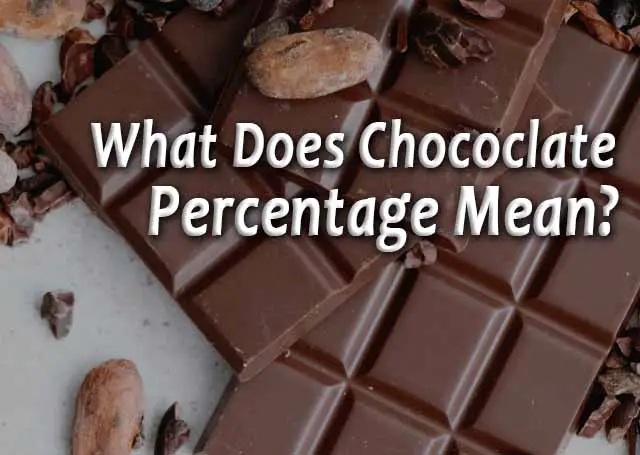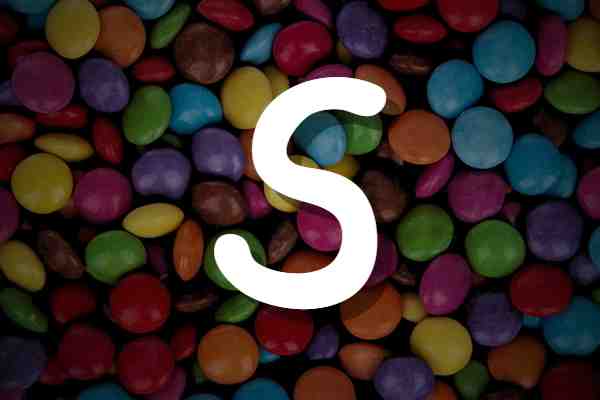If you ever bought a chocolate bar (who hasn’t?), you may notice the term “chocolate percentage” on the label. “55%” is typically seen on milk chocolate and something higher like “85%” is seen on darker chocolates. What does this percentage of chocolate mean?
Chocolate percentages refer to the amount of cacao bean-derived ingredients (chocolate liquor and cocoa butter) used in the chocolate product by weight. Basically, it means how much of the chocolate came from a cacao tree.
For example, milk chocolate is made from milk powder, added sugar (or other sweeteners), and cocoa mass.
What Does Chocolate Percentage Mean?
The chocolate percentage is the proportion of chocolate, by weight, that comes from ingredients derived from cacao beans. These are ingredients like cocoa liquor and cocoa butter. The rest of the ingredients are non-chocolate.
The non-chocolate ingredients are things like:
- Milk – milk powder and condensed milk are common forms of milk added to chocolate.
- Emulsifiers – used to improve “flowability” of chocolate. Better and more consistent texture of chocolate.
- Flavoring – Vanilla or spices.
- Sweeteners – Added sugar, honey, corn syrup.
This percentage is an indicator of the chocolate flavor to sweetness ratio. A higher percentage of chocolate generally means a more intense, bitter chocolate taste (think dark chocolate). A lower percentage chocolate bar is usually sweeter as the cocoa-derived ingredients are replaced with sugar and other flavorings.
It is important to note that a higher percentage of chocolate does not mean a higher quality of chocolate. It is possible for 80% chocolate to taste worse than a fine quality 55% chocolate.
Different Types of Chocolates Mean Different Percentages
Milk Chocolate
This form of chocolate is quite common in candy bars; it contains cocoa butter, cocoa solids (usually in the form of powder), sugar, and an emulsifier.
According to the FDA,
Milk chocolate contains not less than 10 percent by weight of chocolate… The finished milk chocolate contains not less than 3.39 percent by weight of milkfat and not less than 12 percent by weight of total milk solids.
U.S. FDA
This means milk chocolate must contain (by weight):
- At least 10% chocolate (in form of chocolate liquor or cocoa fats)
- At least 3.39% milkfat nad at least 12% milk solids (milk powder)
This is chocolate with milk added usually in the form of powder or condensed milk. Compared to dark chocolate, milk chocolate has a lower total cacao content. Typically, milk chocolate will contain more sugar than dark chocolate (therefore will be sweeter).
White Chocolate
The FDA has defined white chocolate to contain (by weight):
- At least 20% cacao fat
- At least 3.5% milkfat and at least 14% milk solids (milk powder)
- No more than 55% nutritive carbohydrate sweetener (added sugar)
Dark Chocolate
Dark chocolates start at around 55% all the way up to 100%. Though for beginners, this type of chocolate can be challenging to enjoy. It’s an acquired taste.
At 100%, all the undertones become prominent. This dark of a chocolate can taste floral, spicy, nutty, earthy, and even fruity.
Ultimately, it is up to you to decide what percentage of chocolate is preferred.
Related Questions
Does cocoa butter count as part of the percentage of chocolate?
Cocoa butter is an ingredient derived from the cocoa bean so yes, it counts towards the cocoa percentage.
How to enjoy 90% or 100% dark chocolate?
For most people, 90% chocolate is too bitter for the pallette. Start enjoying dark chocolate at 70% and slowly work up. You can start to tell the difference in taste of chocolate and other added ingredients.
It is important to note that most chocolate bars that people eat does not contain that much chocolate to begin with. Milk chocolate bars has a high sugar and milk content than dark chocolates.
Most people that enjoy dark chocolates hover around the 70% range though there are people that genuinely enjoys the upper 90%.
Additionally, most 100% chocolates are made for baking purposes where additional ingredients and sweeteners are added.
What’s the difference between cacao and cocoa?
Cacao refers to the tree plant and cocoa refers to the derived ingredients.





